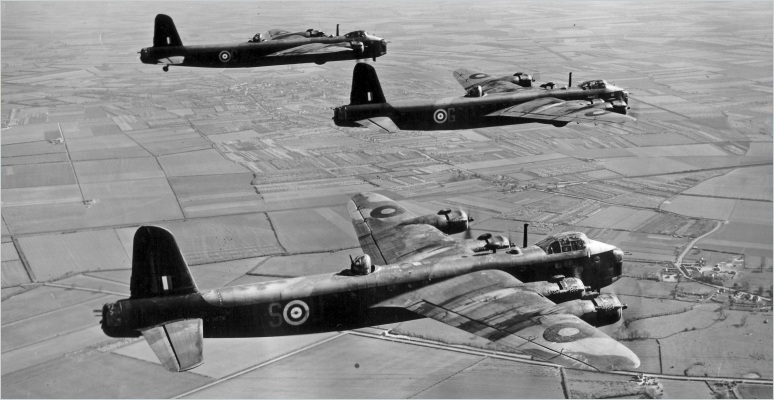The Stirling was the first of Bomber Command's four-engined bombers to enter service. However, its low service ceiling and the entry into service of the Lancaster and Halifax saw it moved to
Transport Command. Operating as a glider tug the Short Stirling would be used during Operation Market Garden.
In July 1936 the Air Ministry issued Specification B.12/36, this requested a four-engined bomber which had a top speed of 230 mph, range of 3,000 miles and a bomb load of 8,000lb. It also had to be
able to hold 24 troops. Of the aircraft submitted to the Air Ministry only two prototypes of both the Short S.29 and Supermarine Type 317 would be ordered. This was followed in 1938 by orders
totalling 200 for the Short S.29. Before production began a half scale research aircraft made of wood, known as the Short S.31, was produced to assess the design and its aerodynamics and this
flew on the 19th September 1938 at Rochester and would be used until 1943, performing over 100 flights. The Supermarine Type 317 would be cancelled after an air raid, in
September 1940, destroyed the aircraft.
Powered by four 1,375-hp Bristol Hercules II engines, and with John Lankester Parker the pilot, and now called the Stirling, the prototype flew for the first time on the 14th May 1939. However,
on landing a brake seized, which resulted in the aircraft being written off, as this caused the undercarriage to collapse. It would not be until the 3rd December 1939 that the second Stirling
prototype flew, using the same engine as the first prototype and featuring changes to its undercarriage.
The 7th May 1940 saw the first Stirling Mk I production version fly. Housing a crew of seven, two pilots, navigator/bomb-aimer, flight engineer, wireless operator/gunner and two gunners, it was
powered by four 1,595-hp Bristol Hercules XI engines. This gave the aircraft a top speed of 255 mph, range of 2,330 miles with a service ceiling of 16,500 ft. Armament was eight 0.303-in machine
guns, located as follows, two in the nose turret, two in the dorsal turret and four in the rear turret, with a bomb load of 14,000lb. The Royal Air Force started to take delivery of their new
aircraft on the 3rd August 1940 when they started to equip No. 7 Squadron, RAF Leeming, which had been reformed on the 1st August 1940.
Production of the Stirling would then be disrupted when on the 15th August 1940, during the Battle of Britain
(10th July 1940 - 31st October 1940), the Shorts factory in Rochester is bombed by the Luftwaffe, meaning production of the type suffers for the next three months. So it would be another six months
before the Stirling performed its first operational sortie, when three from No. 7
Squadron took part in a night raid on oil storage tanks in Rotterdam, Netherlands on the 10th February 1941.
A Stirling Mk II powered by 1,600-hp Wright R-2600 Cyclone engines was to be built in Canada and despite an order for 140 of the type only a small number were produced.
The Stirling Mk III was the next variant and was powered by four 1,650-hp Bristol Hercules XVI engines, it also featured a redesigned dorsal turret and a few changes were made internally. The
aircraft had a top speed of 270 mph, range of 2,010 miles with a service ceiling of 17,000 ft. Armament was eight 0.303-in machine-guns, two each in the nose and dorsal turrets and four in the
rear turret. Bomb load was 14,000lb.
One of the main drawbacks of the Short Stirling was its low service ceiling as a result of its thick wing, although it did also have a positive effect of giving the aircraft an impressive turn
rate and radius, earning the nickname 'the fighter-bomber' due to its manoeuvrability. This meant that on operations alongside the Handley Page Halifax and
Avro Lancaster, which could fly higher, the Stirling was more susceptible to enemy fighters and flak. So when the
Halifax and Lancaster started to enter service in larger numbers the Stirling was to be used for other tasks, So, on the 8th September 1944, No. 149 Squadron used the type on its last operational
sortie for Bomber Command, a raid against targets in Le Havre, France, with the aircraft’s main role after this being that of a glider tug for Transport Command. At its peak, thirteen squadrons
were operational with Bomber Command.
As a result of its new duties the Stirling Mk IV would be produced. This would have it dorsal and nose gun turrets removed, the necessary equipment for glider towing added and a new exit at the
back of the fuselage for the 20 paratroopers the aircraft could hold to jump from. When being used as a glider tug it could tow a pair of Airspeed Horsas
or one General Aircraft Hamilcar glider. It would be No. 299 Squadron, RAF Stoney Cross who received the first of the Stirling Mk IVs to enter service on the 23rd January 1944, replacing their
Lockheed Venturas. The Stirling took part in operations on D-Day, 6th June 1944, and Operation Market Garden (17th September 1944 - 25th September 1944). The Stirling Mk V would be the last
production version and was an unarmed transport aircraft.
When production ended in late 1944 a total of 2,371 Short Stirlings had been made, completing 18,440 sorties, and a dozen saw service after the Second World War (1939 - 1945) as civil aircraft in
Belgium.


